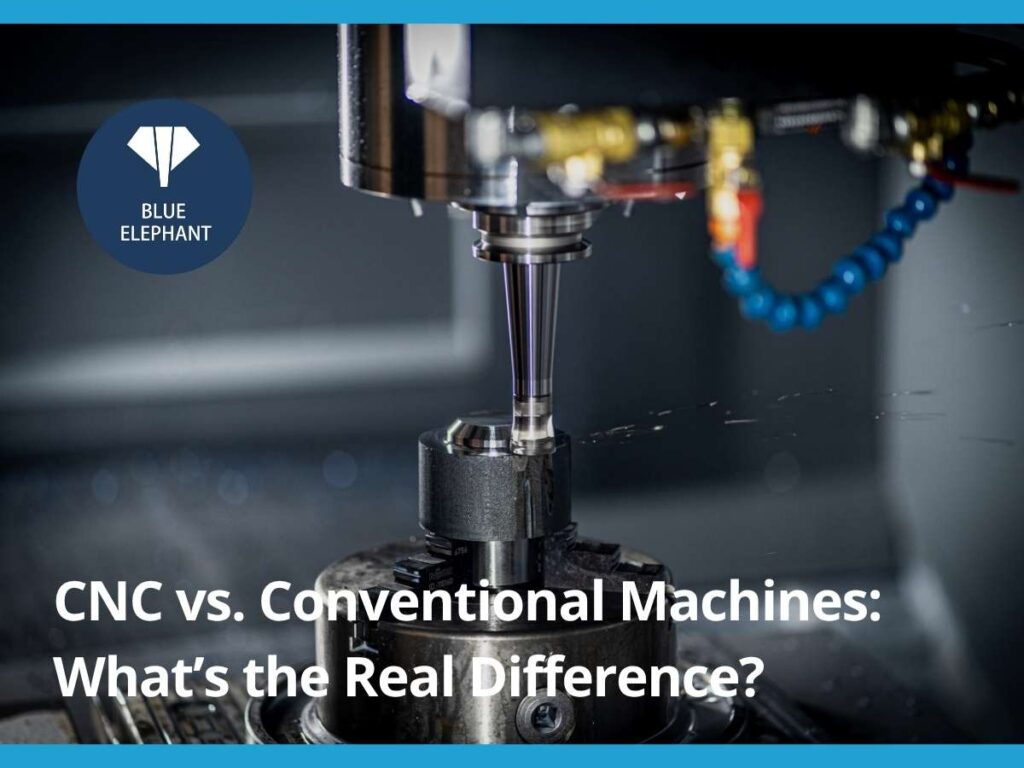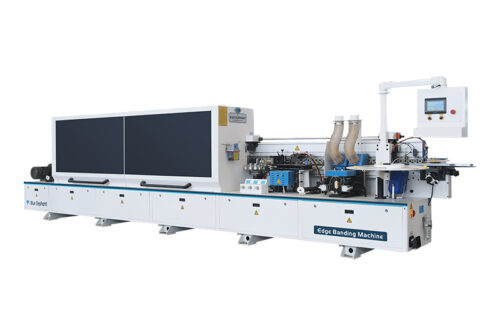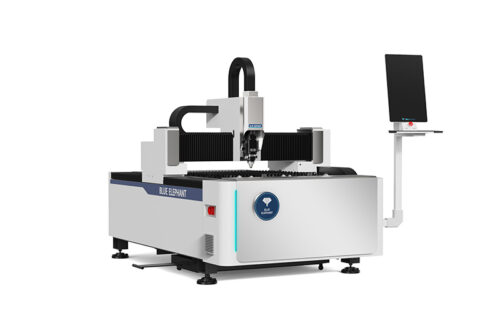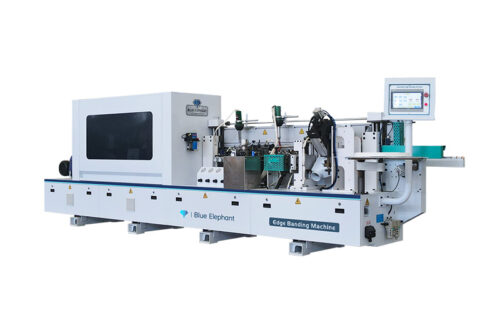A few years back, I bought a machine I thought would change everything. It didn’t. I was sure a Conventional mill would handle my custom parts business just fine.
But the setup took too long, the precision wasn’t there, and scaling up? Nearly impossible. I had to pivot fast—CNC was the better fit.
Since then, I’ve worked with both, pushing them to their limits and learning what truly matters.
In this guide, I’ll break down the real differences—cost, speed, precision, and application—so you don’t make the same mistake I did.
By the end, you’ll have a clear answer on which machine is right for your business.
Let’s get started!
1. Key Differences Between Conventional and CNC Machines
Not sure which machine is right for your shop?
Both have their place—one gives you full control by hand, the other runs by code. I’ve worked with both, and each has its strengths (and headaches).
Here’s a quick look at how conventional and CNC machines really compare—based on real-world use, not just spec sheets.
| Category | CNC Machine | Conventional Machine |
| Operation Method | Software-driven; runs via CAD/CAM and G-code | Operated manually using handwheels and dials |
| Level of Automation | Fully automatic | Fully manual |
| Precision | High accuracy (micron-level) | Depends on operator skill |
| Repeatability | Consistent, job after job | Hard to repeat exact results |
| Skill Requirement | Needs digital skills (CAD/CAM, programming) | Needs hands-on machining experience |
| Production Speed | Fast for batch production | Slower; one step at a time |
| Setup Time | Longer due to programming and testing | Shorter for simple tasks |
| Learning Curve | Steep if you’re new to software | Quicker to learn by doing |
| Maintenance | Needs electronics/software servicing | Fixed with basic tools |
| Repair Frequency | Breaks less often but repairs cost more | Repairs happen more often but are cheaper |
| Software Compatibility | Needs CAM software, controllers, and post-processors | Not required |
| Toolpath Flexibility | Handles 2D and 3D geometry | Limited to simple shapes |
| Initial Investment | Higher (machine + software + PC) | Lower (basic workshop setup) |
| Operating Cost | Lower labor cost per part; higher energy use | Higher labor cost per part |
| Material Waste | Minimal (optimized paths) | More waste from manual mistakes |
| Operator Fatigue | Low; mostly hands-off during cuts | High; full physical involvement |
| Best Application | Mass production, high-precision jobs | Repairs, one-off jobs, general-purpose work |
| Scalability | Easy to scale with programs and libraries | Scaling = hiring more trained workers |
| Adjustments | Slower to modify mid-process | Easy to tweak while working |
| Space and Power | Needs stable power, PC, ventilation | Works in smaller shops; less power needed |
| Best User Type | Manufacturers, machine dealers, production teams | Hobbyists, small workshops, service technicians |
Now that you’ve seen the overview, let’s take a closer look at each type of machine.
2. Cost Comparison: Which One is More Cost-Effective?
Standing in a machine shop, looking at price tags, the choice seems obvious. A solid conventional lathe costs around $5,000. A CNC machine? Easily $30,000 or more.
At first glance, conventional machines appear to be the better deal. But are they really? Let’s break down the true costs—beyond just the price tag.
Initial Investment
- Conventional Lathe or Mill: $2,000 – $10,000
- Entry-Level CNC Machine: $15,000 – $50,000
- High-End CNC Machine: $50,000 – $100,000+
Operating and Maintenance Costs
Conventional Machines: Lower Maintenance, Higher Labor Costs
- Hands-on operation means you or an employee must manually control every cut.
- Longer production time increases labor costs, especially for repetitive tasks.
- More material waste due to human error.
CNC Machines: Higher Maintenance, Lower Labor Costs
- Requires software updates and part replacements, adding to maintenance costs.
- Less operator fatigue, since one person can run multiple machines at once.
- More efficiency, less waste, leading to long-term savings.
At first, CNC machines cost more. But over time, they save money by reducing labor and improving precision.
Return on Investment (ROI): Which One Pays Off Faster?
If you only make custom, one-off parts, a conventional machine makes sense. The upfront cost is low, and it’s great for repairs and small projects.
If you need precision, repeatability, and volume, CNC machines win. They work faster, reduce waste, and handle bulk orders with ease. Over time, they pay for themselves.

3. Suitability for Different Applications
Not every machine is built for the same job. A high-production factory has different needs than a small repair shop. The right choice depends on what you make, how often you make it, and how precise your work needs to be.
So, which machine fits your work best?
CNC Machines
CNC machines shine in industries where accuracy, speed, and efficiency are key. If you need identical parts produced quickly, a CNC machine is the better option.
At Blue Elephant, our CNC machines are designed to help businesses scale production without sacrificing quality. Whether you’re cutting wood, metal, or composites, CNC technology allows for flawless precision and minimal waste—something that’s nearly impossible to achieve manually.
- Furniture & Cabinet Manufacturing: Cuts and drills wood with consistency.
- Aerospace & Automotive: Produces precision parts with tight tolerances.
- Medical Equipment: Ensures uniformity for surgical tools and implants.
- Mold Making & Injection Molding: Handles intricate designs that conventional machines struggle with.
- Metal Fabrication: Works with strong materials like steel and titanium.
Factories that need thousands of identical parts benefit most from CNC. A CNC machine can run 24/7 with minimal supervision, cutting production time and reducing waste.
A shop owner once told me how his CNC router produced 50 furniture panels in a single afternoon. Before that, his team took two days to do the same job manually. That kind of speed is hard to ignore.
But not everyone needs that level of automation.
Conventional Machines
- Craftsmen & Artisans: Great for hand-carved details and engraving.
- Repair Shops: Essential for fixing custom parts and one-off repairs.
- Prototyping & R&D: Allows for quick design changes before mass production.
- Small Workshops & Rental Businesses: Lower initial investment and easier maintenance.
- Machinist Training: Builds fundamental machining skills without relying on automation.
A machinist I knew specialized in restoring classic car parts. He loved his conventional lathe because it let him make precise adjustments without programming a computer. For him, the feel of the machine mattered more than speed.

4. Speed & Efficiency
When you’re working against a deadline, every second counts. Whether you’re cutting metal, shaping wood, or engraving details, speed matters. But speed isn’t just about how fast a tool moves—it’s also about efficiency, setup time, and repeatability.
So, which machine finishes the job faster? Let’s compare.
Conventional Machines: Hands-On but Slower
Conventional machines rely on the operator to adjust every setting. Each movement—turning handwheels, positioning materials, setting cutting depths—takes time. If you’re machining a single custom part, this hands-on approach can be quick to start but slow to finish.
- Faster setup for one-off projects: If you just need to drill a hole or make a small adjustment, a conventional machine gets going right away.
- Time-consuming for complex tasks: The more detailed the job, the longer it takes. Adjustments must be made manually, and mistakes lead to wasted time and material.
- Limited repeatability: If you need five identical parts, you’ll have to reset everything for each one.
CNC Machines: Fast, Efficient, and Repeatable
CNC machines run on automation, making them much faster for repetitive tasks. Once programmed, the machine cuts, drills, or engraves without needing constant adjustments.
At Blue Elephant, our CNC machines are built for high-speed production and precision. Businesses that rely on batch production use CNC to increase efficiency and reduce waste—something a coventional machine can’t compete with.
- Faster production cycles: CNC machines work quickly because they don’t rely on manual adjustments.
- Ideal for batch production: Need 100 identical parts? A CNC machine does it flawlessly and efficiently.
- Reduced human fatigue: The operator sets up the job, presses start, and the machine does the rest.
A CNC operator once told me he produced 50 precision-cut panels in an afternoon—a task that would’ve taken him days on a conventional machine.
5. Skill Level & Operator Training
Choosing between conventional and CNC machines isn’t just about cost or speed—it’s also about who will operate them. Training requirements vary, and depending on your team’s skill level, one machine may be a better fit than the other.
Some businesses rely on experienced machinists who have been working with conventional machines for years. Others prefer to train employees on CNC systems, allowing for faster production and automation. Which approach works best for your business?
Training for Conventional Machines
Conventional machines require skill, patience, and years of hands-on experience. Unlike CNC, where software guides the process, a machinist must control every movement manually.
- Takes years to master: Operators need to understand feeds, speeds, and how different materials react.
- Requires a sharp eye for detail: Small errors can result in wasted material and lost time.
- Teaches fundamental machining principles: Many machinists start with conventional machines before moving to CNC.
A machine shop owner once told me how his most skilled machinist had been using conventional machines for over 20 years. His expertise was irreplaceable for custom, one-off parts that required careful adjustments. But training a new machinist to reach that level? That could take years.
For businesses that rely on custom work and craftsmanship, conventional machining skills are invaluable. But for companies that need faster production with less labor dependency, CNC is the smarter choice.
Training for CNC Machines
CNC machines reduce human error and require less physical involvement, but they do require a different kind of skill—programming. Operators must learn G-code and use CAD/CAM (Computer-Aided Design/Manufacturing) software to control the machine.
- Training programs shorten the learning curve: Employees can become CNC operators in weeks, not years.
- Easier to scale production: Once a design is programmed, the machine can run continuously.
- Less reliance on highly skilled machinists: Companies can train multiple operators quickly.
A manufacturing manager I spoke with shared how he transitioned his shop from conventional to CNC machining in under a year. Instead of struggling to find highly skilled machinists, he trained his existing team to operate CNC machines—increasing efficiency without increasing labor costs.
6. Maintenance and Repair
Every machine needs maintenance. The question is—how much work, how often, and at what cost? Some businesses prefer machines that can be repaired in-house. Others need advanced systems that require professional servicing.
A machine that’s down isn’t making money. So, which one is easier to keep running?
Conventional Machines
A machinist once told me, “If my conventional lathe stops working, I grab my toolbox, not the phone.” That’s the advantage of conventional machines—most repairs are straightforward and don’t require outside help.
- Mechanical parts are easy to replace: Belts, gears, and bearings are standard and widely available.
- No complex electronics: No circuit boards or software failures to troubleshoot.
- Lower maintenance costs: Most repairs can be done in-house with basic tools.
- Minimal downtime: If something breaks, an experienced machinist can often fix it the same day.
Conventional machines are ideal for businesses that need reliable, long-lasting equipment with low maintenance costs. But as production demands grow, some businesses find they need more automation.
CNC Machines
CNC machines are faster, more precise, and more efficient, but maintenance can be complicated. Unlike Conventional machines, they rely on electronics, software, and automation, which means repairs aren’t always simple.
- Software updates are required: CNC machines run on G-code and CAD/CAM programs, which need regular updates.
- Parts are expensive: Motors, controllers, and sensors cost more than manual components.
- Specialized technicians are needed: If a servo motor or circuit board fails, it often requires an expert to fix it.
- Downtime can be costly: If a CNC machine goes down, production stops, which can mean lost revenue.
One manufacturer I spoke with had a CNC router fail because of a faulty control board. It took 2 weeks to get the part and schedule the repair. For high-volume production, that kind of delay can be a serious setback.

7. Space & Infrastructure Requirements
Not every shop has unlimited space. Some machines fit neatly into a small garage, while others demand large factory floors and dedicated power systems. Before choosing between Conventional and CNC machines, it’s important to ask:
- How much space is available?
- Can the power supply handle the load?
- Will additional infrastructure like cooling or ventilation be needed?
Each machine type has different requirements, so planning ahead is essential.
Conventional Machines: Compact and Flexible
- Fits in smaller shops: A lathe, drill press, or milling machine can be set up in a single corner.
- No special power requirements: Most conventional machines run on standard electrical outlets.
- Easier to move and rearrange: Lighter than CNC machines and can be repositioned without major effort.
CNC Machines
- Requires dedicated floor space: Some CNC routers and mills take up several square meters.
- Higher power demands: Many CNC machines need three-phase power, which isn’t standard in small shops.
- May require cooling or dust collection: High-speed cutting generates heat, requiring cooling systems for metal machining or vacuum systems for wood dust.
8. Which Machine Should You Choose?
Choosing between conventional and CNC machines depends on your work, budget, and long-term goals. Each has its strengths. One offers flexibility and hands-on control. The other delivers speed and precision through automation.
So, which one is the right fit for your business?
High-Volume and Precision
If you need speed, accuracy, and repeatability, CNC machines are the best option. They are ideal for mass production, allowing businesses to produce hundreds or thousands of identical parts with no variation. The precision of CNC machines makes them essential for industries like aerospace, medical, and automotive manufacturing, where tolerances can be as tight as ±0.001 inches.
Another advantage of CNC machines is automation. Once programmed, they can run with minimal supervision, reducing the need for skilled conventional labor. This means less operator fatigue and higher efficiency, making them the preferred choice for businesses focused on large-scale production. Though the upfront cost is higher, the long-term savings in labor and material waste often make CNC a smart investment.
Flexibility and Lower Costs
If you focus on custom work, repairs, or small-batch production, conventional machines might be the better choice. They are more affordable, making them ideal for small businesses or workshops with budget constraints. Unlike CNC machines, they don’t require programming, which allows machinists to make adjustments in real time without dealing with software.
Conventional machines are great for one-off projects where precision is important but mass production isn’t necessary. Many repair shops and custom fabrication businesses rely on them because they allow creative problem-solving and modifications without long setup times. Since they are also easier to maintain, they remain a reliable choice for many industries.
Conclusion
Standing in front of that first CNC machine, I hesitated. Was it worth the cost? Would it change my business? Looking back, I know the answer now.
Conventional machines offer control, flexibility, and a lower cost. CNC machines bring speed, precision, and automation. Each has a place. The real question is—which one fits your future?
Your business deserves the right tool. One that helps you work smarter, grow faster, and produce with confidence.
What will you choose?
If you’re ready to take the next step, contact us today. Let’s find the right machine for you.
More Guides and Tips to Explore
If you’re looking for more insights, we’ve put together a list of helpful articles that you might enjoy:
Still haven’t found what you’re looking for? Don’t hesitate to contact us. We’re available around the clock to assist you.













